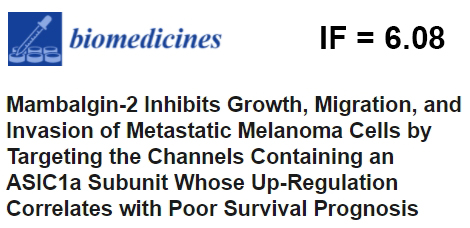Press-room / news / Science news /
Mambalgin-2 inhibits growth, migration, and invasion of metastatic melanoma cells by targeting the channels containing an asic1a subunit whose up-regulation correlates with poor survival prognosis
Melanoma is aggressive cancer characterized by acidification of extracellular environment. Scientists from the Laboratory of bioengineering of neuromodulators and neuroreceptors IBCh RAS together with colleages from NN Blokhin NMRCO showed for the first time that extracellular media acidification increases proliferation, migration, and invasion of patient-derived metastatic melanoma cells and up-regulates cell-surface expression of acid sensitive channels containing the ASIC1a, α-ENaC, and γ-ENaC subunits. No influence of media acidification on these processes was found in normal keratinocytes.
To control metastatic melanoma progression associated with the ASIC1a up-regulation, we proposed the ASIC1a inhibitor, - mambalgin-2 from Dendpoaspis polylepis venom. Recombinant analog of mambalgin-2 cancelled acidification-induced proliferation, migration, and invasion of metastatic melanoma cells, promoted apoptosis, and down-regulated cell-surface expression of prooncogenic factors CD44 and Frizzled 4 and phosphorylation of transcription factor SNAI. Confocal microscopy and affinity purification revealed that mambalgin-2 interacts with heterotrimeric ASIC1a/α-ENaC/γ-ENaC channels on the surface of metastatic melanoma cells. Using the mutant variant of mambalgin-2 with reduced activity toward ASIC1a, we confirmed that the principal molecular target of mambalgin-2 in melanoma cells is the ASIC1a subunit. Bioinformatic analysis confirmed up-regulation of the ASIC1 expression as a marker of poor survival prognosis for patients with metastatic melanoma. Thus, targeting ASIC1a by drugs such as mambalgin-2 could be a promising strategy for metastatic melanoma treatment.
This work was supported by the Ministry of Science and Higher Education of the Russian Federation (№ 075-15-2020-773) and published in Biomedicines journal.
october 16, 2021


